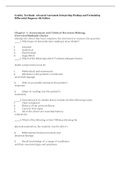Exam (elaborations)
Test Bank - Advanced Assessment: Interpreting Findings and Formulating Differential Diagnoses 4th Edition by Mary Jo Goolsby, (All Chapters Included).
- Course
- Institution
- Book
Test Bank for Advanced Assessment: Interpreting Findings and Formulating Differential Diagnoses 4th Edition by Mary Jo Goolsby. Full Chapters Include;... I. The Art of Assessment and Clinical Decision Making 1. Assessment and Clinical Decision Making: An Overview 2. Genomic Assessment: Interpreting...
[Show more]



